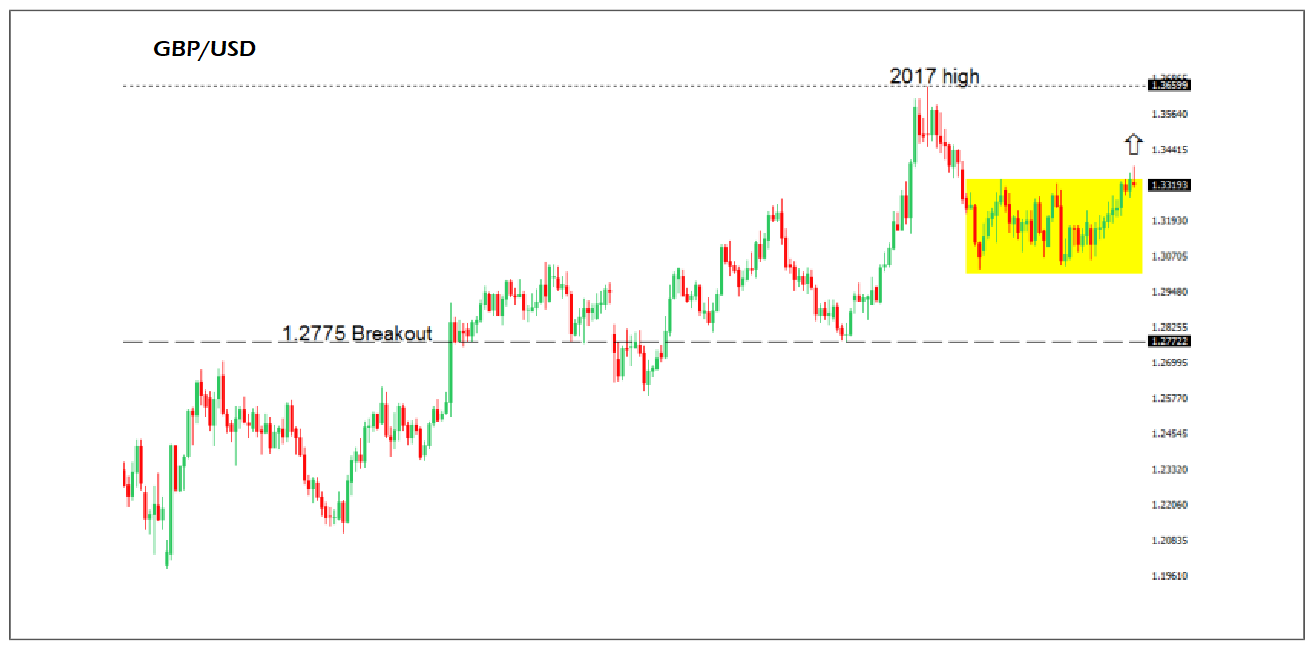Pound-to-Dollar Rate Breaks Important Ceiling; Next Stop 1.36 October Highs?

The Pound-to-Dollar is breaking out higher, and could go all the way to 1.4000 as long as the Irish border issue doesn't get in its way says LMAX Exchange's Joel Kruger.
When exchange rates break out of ranges they have been trading in for a while, it tends to be a big deal, and this is precisely what has happened on GBP/USD.
Take the chart below, produced by LMAX Exchange's market analyst Joel Kruger, which illustrates the point amply; the Pound-to-Dollar rate is breaking out above a sideways range (shaded in yellow) which it has been in for many weeks now.
"The market has broken out to the topside, signaling the end to a range that had defined price action since early October," says Kruger.
There is a strong possibility that this could be signaling a continuation of the 2017 rally, although a break above the October highs would be required for confirmation, and these are still quite far away at 1.3658.
Yet if the market does manage to get above those highs, Kruger sees it going all the way up to 1.4000.
"The market is poised for a continuation of the 2017 uptrend, with a higher low possibly in place at 1.3027, to be confirmed on a break of the 2017 high at 1.3658, opening the door for a push over the coming weeks and months back above 1.4000," says the analyst.
How High Can Cable Go?
Technical lore has it that a breakout from a sideways range usually results in a move the same distance as the height of the range extrapolated higher (or lower in the case of a bearish break), and so our own view is that the pair will probably move that far higher.
Given the height of the range is just over 300 points (from 1.3027 to 1.3340) we would expect the exchange range to travel the same distance higher, targeting the 1.3658 highs, most likely.
Fundamental Drivers
Kruger suggests some interesting fundamental drivers for more upside, with the main one being an improvement in Brexit negotiations driving up the Pound.
It seems Theresa May's offer of 40bn to settle Brexit has improved the chances of talks moving to the next stage.
The US Dollar has lost ground, however, due to fresh concerns about long-term low inflation.
Low inflation will prevent the Federal Reserve (Fed) from raising interest rates which will weigh on the Dollar which prefers higher interest rates as they attract greater inflows of foreign capital, drawn by the promise of higher returns.
"The combination of a more favourable outlook relating to the Brexit negotiation process and prolonged Fed subdued inflation concerns are the primary drivers behind the UK currency’s latest run," says Kruger.
Get up to 5% more foreign exchange by using a specialist provider by getting closer to the real market rate and avoid the gaping spreads charged by your bank for international payments. Learn more here.
Irish Border Risk
The main downside risk to LMAX's bullish forecast is related to complications agreeing on the status of the border between the Republic of Ireland, which is still in the EU, and Northern Ireland, which is a part of the UK.
Post-Brexit the Irish don't want to erect a physical border with Norther Ireland - mainly because of the negative consequences it will have for the vast amount of trade which takes place across it, but also because it will be costly to manage, and unpopular.
The last point is also significant in light of the impending snap general election scheduled to be held in Ireland on December 18.
The possibility of a physical border could reignite deeper political enmities between the two nations which go back to Cromwellian times.
Many canvassing Irish politicians have adopted a hardline 'no-border' stance ahead of the elections, in a bid to attract the nationalist, Sien Finn, vote.
They have even raised the possibility of using their vote on the European council to veto any attempts to move to stage two of Brexit negotiations until a promise not to erect a wall has been guaranteed.
The only other real solution to not having a border would be to somehow arrange a carve-out clause to give N.Ireland a hybrid status so that it remained within the EU - but still a part of the UK as well.
The problem with this solution is that the Prime Minister's allies in parliament, the DUP, are dead against any special dispensation which would differentiate N.Ireland from the rest of the UK, and she relies on their votes to give her a majority.
The Irish question, therefore, has the potential to derail negotiations.
Upside from Irish Issue
Although LMAX's Kruger does not mention it, looked at from a different angle, the Irish problem could also yield a solution which could help Sterling, as it could breathe life into the proposal for a much softer Brexit in which the UK retained membership of the customs union, and possibly the trade union, with a status akin to Norway.
This is the recommendation of the Irish commissioner to the EU Phil Hogan, anyway, who stated recently that it would better all round if the UK retained membership of the trade and customs union, which would have the benefit of allowing the border to remain transparent.
Yet he added that this would also be better for the UK as he does not think politicians in London fully understand the consequences of leaving the trade and customs union, in terms of the real cost to jobs and the economy, and it would be better for all concerned if the Uk at least retained membership of the customs union.
Get up to 5% more foreign exchange by using a specialist provider by getting closer to the real market rate and avoid the gaping spreads charged by your bank for international payments. Learn more here.










